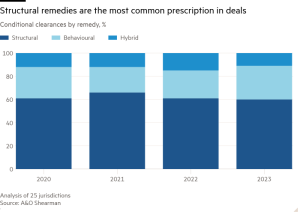More than 60 die in Spanish floods
Unlock the Editor’s Digest for free
Roula Khalaf, Editor of the FT, selects her favourite stories in this weekly newsletter.
More than 60 people have died in southern and eastern Spain as towns were submerged and road and rail links severed in the most devastating flash floods to hit Europe for several years.
Local authorities said at least 62 people had died in the Valencia region after torrential rains hit the area on Tuesday, with officials warning that the death toll was likely to rise and extend to neighbouring regions.
“These are very difficult hours for relatives and for the disappeared,” said Carlos Mazón, president of the Valencia government, on Wednesday. “Right now it’s impossible to offer a precise figure [on the number of victims]. We’re in shock.”
In Madrid, Prime Minister Pedro Sánchez chaired a crisis meeting on the floods. “We cannot yet say that this disastrous episode is over,” he said in an earlier televised address.
The disaster also raised questions about the way the authorities alerted residents to the forecasts of intense rain, and the role of climate change in provoking it. Ursula von der Leyen, president of the European Commission, said recent heavy floods in Europe were the “dramatic reality of climate change” and called on EU countries to make better preparations for extreme weather events.
The death toll was expected to be the worst caused by flooding in Europe since 2021, when unprecedented rain took the lives of more than 200 people in Germany and Belgium.
Spain’s state weather agency Aemet said the storm was the most intense to hit the region since the 1980s. Chiva, a town 30km west of the city of Valencia, had a year’s worth of rainfall in just eight hours, the BBC reported.
Videos on social media in Spain showed people clinging to trees to avoid being swept away, firefighters rescuing drivers trapped in cars and other vehicles being consumed by muddy flood waters.
Mazón said some people remained stranded in areas that it was “absolutely impossible” to reach and others were without power and telephone communications.
High-speed trains connecting Valencia to Madrid and Barcelona were suspended and some flights due to land at Valencia airport were diverted to other cities. Schools and other public services in the worst-hit areas were closed.


Aemet first issued a “red alert” about the high probability of intense rain in the Valencia region at 7.36am on Tuesday, but experts said it failed to communicate the severity of the situation.
Professor Liz Stephens, professor in climate risks and resilience at the UK’s Reading university, said: “While a red weather warning was issued for the region with sufficient time for people to move out of harm’s way, a red warning alone doesn’t communicate what the impact will be and what people should do.”
She added: “Climate scientists have been warning for years that climate change will lead to more intense rainfall, and the tragic consequences of this event show that we have a long way to go to prepare for this kind of event, and worse, in future.”

Spanish media outlets reported that separate warnings from a public safety agency were only sent to residents’ mobile phones after 8pm on Tuesday, when many people were already trapped in their homes or cars by floodwaters.
Aemet described the intense rain as the result of a “cold drop”, which occurs when cold air moves over the warm waters of the Mediterranean Sea and leads to the rapid formation of giant cumulonimbus rain clouds.
Climate Capital

Where climate change meets business, markets and politics. Explore the FT’s coverage here.
Are you curious about the FT’s environmental sustainability commitments? Find out more about our science-based targets here
#die #Spanish #floods



